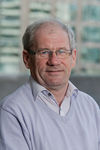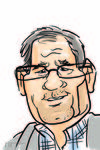Rudi Vansnick
 |
 | ||
| Country: | Belgium | ||
| Email: | rudi.vansnick [at] isoc.be | ||
| Website: | |||
| Facebook: | |||
| LinkedIn: | |||
| Twitter: | |||
|
| |||
Rudi Vansnick, being the President of ISOC Belgium, was elected in 2012 to the board of trustees of Internet Society for a 3-year mandate.
Rudi was a member of the ISOC ECC Board, and an original sponsor for the creation of EURALO, where he served on the board and participated in working groups;[1] such as EuroDIG.[2] His term on the EURALO board was set for 2007 - 2013.[3]
In 2013 Rudi joined the Not-for-Profit Operational Concerns NPOC constituency, member of NCSG - GNSO. He was elected chair of the Policy Committee for the period July 2013 - June 2014. In this capacity, he served on the NCSG Policy Committee. During the ICANN 50 London meeting (21-26 June 2014) he got elected as chair of NPOC, start serving as such on the 10th of July. IN 2015 his mandate as NPOC's chair got extended for another year.
Global Knowledge Partnership Foundation [4] elected Rudi member of the board of Directors in December 2013. He was also asked to serve as treasurer of the organisation.
Being already a long-standing national expert, the board of Directors of the World Summit Award elected Rudi to be part of this board starting April 2014.
Belgian Internet edit
He has been the president of the Belgian chapter of the The Internet Society since 2000. He participates in national debates with federal and regional governments on topics such as cyber criminality and security issues related to Belgian citizens. In 2004, he became more involved in Internet issues and debates all around the world by attending conferences in Bangladesh, Tunis, Hannover.[5] In 2005, he became the national expert for the World Summit Awards and one of the 38 Grand Jury members from all over the world in electing the 40 best e-Content projects worldwide (2005-2009).
His 30 years of experience in ICT prepared him for a study on the usage of ICT in the Social Profit sector in East-Flanders by ISOC Belgium and EROV. The result of this survey, which ended in 2007, is The ICT Whitebook for the Social Profit.[6] It contains an overview of the ICT inventory in the Social Profit in East-Flanders and several requirements and recommendations for the sector itself, but also for the government and the ICT sector.
In April 2008, the general assembly of TIK, the users' group of Belgian Telecom & Internet customers in with some 10.000 members, decided to elect a new board. Rudi moved from secretary to president for a mandate of 3 years.[7] By selecting Rudi TIK hoped to gain credibility for the organisation in the eyes of the national government, thereby further defending and empowering Internet users.[8]
Career History edit
Rudi Vansnick initially graduated as an accountant, and started his professional career at the Ministry of Agriculture; from there he quickly became involved in the digitization process of government administration. In 1988, he developed the "pharmacy computer" solution and helped to bring communication facilities to pharmacy distribution centres and pharmacists. The system was later implemented in France, Luxembourg, and Germany.
A few years later, he designed and implemented a huge IT architecture for logistics and communication purposes in Hungary for a distribution corporation. More recently, he was involved in the IT-outsourcing contract of the Flemish government for about 2 years; where he gained implementing corporate decisions on a regional and local level such as the Flemish portal website.
In 2006, he began focusing on breaching the Digital Divide through projects in regional and European organisations with a goal to capture the voices of the individual Internet user in an organisational environment. He considers the most difficult hurdle to be the supportive reconciliation of the divide between culture and technology.[9]
Starting in 2007 he got more involved in the ICANN world, first as a co-founder of the EURALO (European Regional At Large Organisation), later as the ccNSO liaison from ALAC (At Large Advisory Committee)(2009-2010). He actively participates in many working groups in the At Large community as well as cross-constituencies.
Conferences edit
Rudi has participated in the International Conference in Washington focusing on the Rights and Protection of Children in the Web 2.0 World. An issue he was already involved in during the Round table in June 2006 in Brussels, in presence of Ms. Viviane Reding and several important authorities. Following this congress, he participated in the workshop organised by ETSI in February, focusing on what should be done by IT companies for children up to 12 years of age.
In 2008, Universal Peace Federation nominated Rudi as an Ambassador for Peace during the Global Peace Festival in Tokyo.[10]
Mr. Vansnick continues to participate in conferences as an expert in Internet policy and governance as well as the technology involved in the Internet.
Affiliations edit
- ISOC Belgium, President Belgian Chapter.[11]
- NPOC (NCSG) chair NPOC - Treasurer 2014 - [www.npoc.org]
- WSA member board of directors - [12]
- World Summit Award, National expert, Organiser of the Belgium World Summit Award 2005 - 2013.[13]
- GKPF - Global Partnership Foundation - member board of directors & treasurer (2013 - )[14]
- TIK, President.[15]
- ICANN At Large Structure, Member
- ISOC USA, member of the Board of Trustees (2012-2015).
- Grand Jury WSA, Member, 2005 and 2009. [16]
- NPOC (NCSG) NPOC Policy Committee chair - Treasurer 2013-2014 [www.npoc.org]
- European Regional At Large Organisation (EURALO), Board Member, 2007-2013. [17]
- ALAC, ccNSO Liaison, 2009-2010.
- Steering Committee Global Forum, Member, 2006 - 2009.
- UPF, Ambassador for Peace.
- Owner - manager of several companies (2010-)
References edit
- ↑ ICANN
- ↑ ICANN-EURALO Events
- ↑ ICANN-EURALO
- ↑ GKPF
- ↑ ICANN
- ↑ [www.ictwitboek.be ICTWhitebook]
- ↑ Translated TIK Council Page
- ↑ Rudi Vansnick's profile
- ↑ Rudi Vansnick's profile
- ↑ comaser.be Rudi Vansnick's profile
- ↑ [www.isoc.be ISOC BE]
- ↑ World Summit Award
- ↑ [www.wsa-belgium.be WSA BE]
- ↑ GKPF
- ↑ [www.tik.be TIK vzw]
- ↑ World Summit Award
- ↑ ICANN-EURALO
ICANNWiki: Content Guide | Documentation | Development Categories: Articles needing attention | Candidates for deletion Projects: Internet & Digital Governance Library
